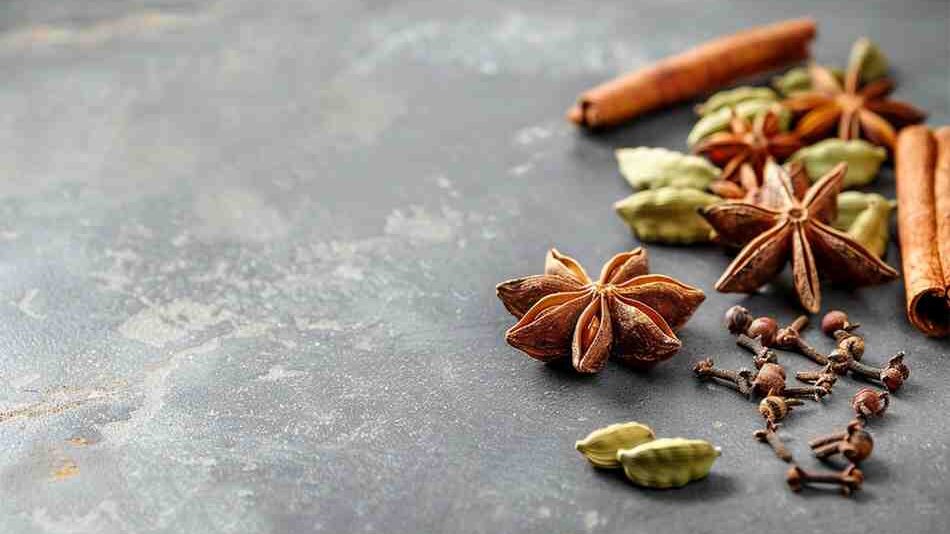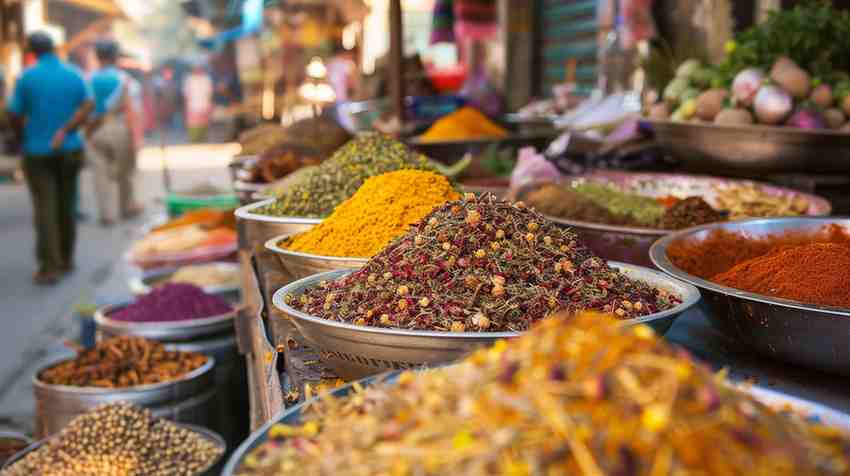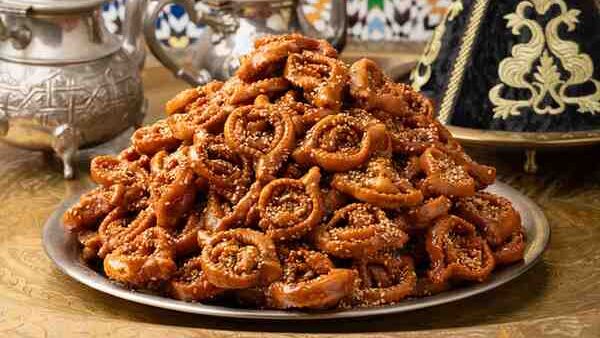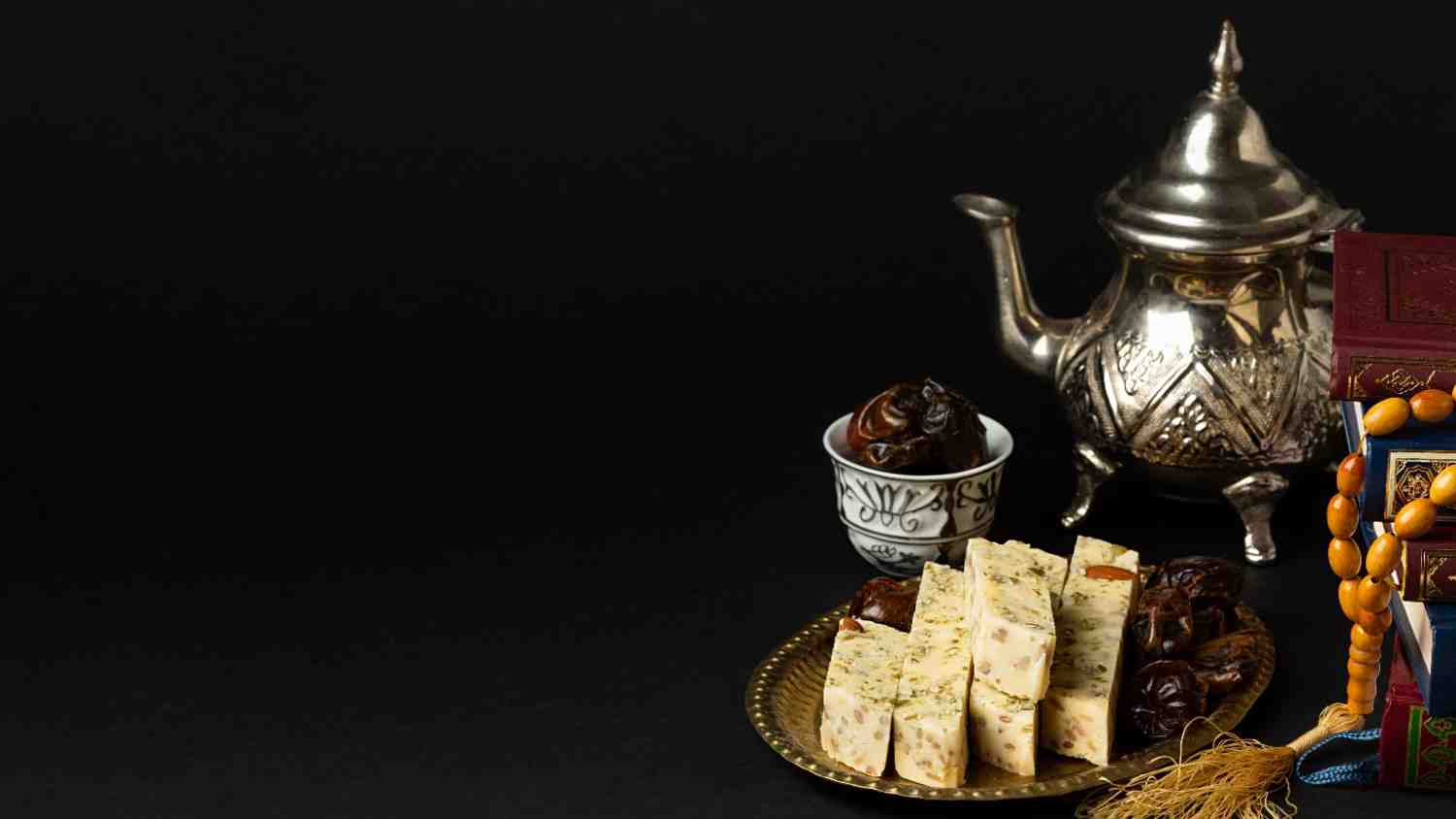Khoudenjal is a traditional Moroccan spiced tea, deeply cherished for its warming qualities, especially during winter. This tea is not just a beverage; it’s a symbol of Moroccan hospitality and culture. It combines a unique array of spices, creating a comforting and aromatic drink. In Morocco, people gather around cups of Khoudenjal, enjoying its rich flavor while sharing stories and warmth. You’ll often find this tea in Moroccan homes, bustling markets, and along the streets of cities like Marrakech and Fes.
The Core Ingredients
The flavor of Khoudenjal comes from a careful blend of spices. Each one adds its unique taste, creating a balanced and complex brew that warms the body and soothes the soul. In Morocco, Khoudenjal is also spelled as Khdenjal, Khoulenjal, or Khoulenjan.”
Galangal Root (Khoudenjal)
- Flavor Profile: Galangal, also known locally as Khoudenjal, defines the tea’s unique character. It provides a warm, peppery kick with a hint of citrus, creating a vibrant and refreshing flavor.
- Health Benefits: Galangal is known for easing digestion and soothing sore throats. It also contains anti-inflammatory properties that help reduce muscle aches during colder months.
Cinnamon Sticks
- Flavor Profile: Cinnamon brings sweet, woody notes to the blend. Its warmth complements the sharper spices, adding a cozy depth that balances the tea’s intensity.
- Health Benefits: Cinnamon helps improve circulation, making it ideal for cold days. It also helps stabilize blood sugar levels, offering a gentle, natural energy boost.
Cloves
- Flavor Profile: Cloves contribute a strong, aromatic layer with a hint of spiciness. They enrich the tea’s flavor, adding complexity that pairs well with cinnamon.
- Health Benefits: Cloves can soothe coughs and clear nasal congestion. Their natural antiseptic properties make them a good choice for supporting respiratory health during winter.
Cardamom Pods
- Flavor Profile: Cardamom offers a citrusy, floral note that lightens the tea’s overall profile. It adds a fresh finish, balancing the richer spices.
- Health Benefits: Cardamom supports digestion and helps reduce bloating, making it a useful ingredient after hearty meals.
Star Anise
- Flavor Profile: Star anise adds a hint of licorice-like sweetness. It softens the blend’s sharp edges, creating a smooth, rounded flavor.
- Health Benefits: Star anise contains antioxidants that boost the immune system, helping the body fend off colds.

Additional Warming Spices
To enhance the richness of Khoudenjal, additional spices provide depth and warmth. These ingredients create a layered flavor that lingers with each sip.
Ginger
- Flavor Profile: Ginger introduces a spicy warmth that complements the other spices. It provides a gentle heat that warms you from the inside out.
- Health Benefits: Ginger boosts immunity and helps alleviate nausea. Its warming nature makes it ideal for cold, winter days.
Nutmeg
- Flavor Profile: Nutmeg offers a sweet, nutty taste that pairs perfectly with cinnamon and cloves. It gives the tea a smooth, cozy finish.
- Health Benefits: Nutmeg promotes relaxation and helps improve sleep quality, making it a great choice for evening tea.
Mace (Nutmeg Flower)
- Flavor Profile: Mace, which is the outer layer of the nutmeg seed, has a lighter, more floral taste. It adds a delicate sweetness that balances the blend.
- Health Benefits: Mace helps with digestion and can improve appetite, offering a gentle, soothing effect.
Black Peppercorns
- Flavor Profile: Black peppercorns bring a bold, sharp heat that contrasts with the sweeter notes. They create a spicy kick that enhances the overall warmth.
- Health Benefits: Black pepper stimulates digestion and helps clear sinuses, making it especially useful when battling a cold.
White Peppercorns
- Flavor Profile: White peppercorns provide a milder heat compared to black pepper. Their slightly floral note adds balance without overwhelming the blend.
- Health Benefits: White pepper also supports digestion, making it a gentle way to warm up the body.
Aromatic and Herbal Accents
Khoudenjal’s complexity is further enriched by the addition of herbal and floral elements. These accents elevate the tea’s taste, adding layers of subtle flavors.
Rose Petals
- Flavor Profile: Rose petals add a light floral sweetness, softening the intensity of the spices. They give the tea a touch of elegance.
- Health Benefits: Rose petals have calming properties, which help reduce stress and promote relaxation.
Pennyroyal (Mentha pulegium)
- Flavor Profile: Pennyroyal introduces a fresh, minty note that brightens the overall flavor, making the tea feel more balanced.
- Health Benefits: Pennyroyal is traditionally used to ease stomach discomfort, making it a great addition for a smoother tea experience.
Nigella Seeds (Black Seed)
- Flavor Profile: Nigella seeds add a mildly nutty, peppery taste, enhancing the complexity of the brew.
- Health Benefits: Known for their immune-boosting effects, these seeds help strengthen the body during the winter months.
Saffron Threads
- Flavor Profile: Saffron offers a rich, earthy aroma and a beautiful golden hue. It gives the tea a luxurious finish.
- Health Benefits: Saffron is believed to lift the mood and improve overall well-being, making it a cherished ingredient in Moroccan tea blends.
Myrtle Leaves
- Flavor Profile: Myrtle leaves add a resinous, slightly sweet note, which pairs well with the richer spices. They give the tea a smooth, rounded finish.
- Health Benefits: Myrtle helps with respiratory issues, adding an extra layer of comfort to Khoudenjal.
Cultural Significance of Khoudenjal

Khoudenjal is not just a winter drink—it’s an essential part of Moroccan culture and tradition. It connects people through shared warmth and stories, becoming a symbol of togetherness.
Khoudenjal in Moroccan Tradition
Moroccans turn to Khoudenjal as soon as the winter chill sets in. This tea has become a key part of the season, providing warmth and comfort. Vendors in vibrant markets, such as the famous Jemaa el-Fnaa in Marrakech, prepare large pots of Khoudenjal, filling the air with its rich, spicy aroma. As people stroll through the markets, they find comfort in a steaming cup, enjoying the blend of flavors that tell a story of Moroccan heritage.
- A Ritual of Warmth: Making Khoudenjal often brings families together. Many gather in the kitchen, sharing laughter and stories as the tea steeps and the spices fill the room with their scent. This process is as much about the experience as it is about the tea.
- Seasonal Appeal: While Khoudenjal is perfect for winter, it’s also enjoyed during special occasions and celebrations. Its rich spice blend adds a festive touch to gatherings, making each event feel even more special.
Preparation, Serving, and Health Benefits of Khoudenjal
Khoudenjal, with its rich blend of spices, offers more than just a delicious flavor—it provides a ritualistic experience that invites relaxation and warmth. Preparing and serving this tea involves careful attention to detail, ensuring that every ingredient releases its full potential. Alongside the satisfying taste, Khoudenjal’s spices bring various health benefits, making it a popular choice during the colder months.
Preparation Method
Brewing Khoudenjal at home is straightforward but requires a few essential steps to achieve the perfect balance of flavors. By following these guidelines, you can replicate the comforting taste of Moroccan markets and street vendors right in your kitchen.
Step-by-Step Brewing Process
- Prepare the Base Tea:
Begin with gunpowder green tea—this traditional choice serves as the foundation for Khoudenjal. Add 2-3 tablespoons of the tea to a Moroccan Berrad (teapot) along with a liter of freshly boiled water. Let the tea steep for about 3-5 minutes to extract its robust, slightly smoky flavor. - Rinse the Tea:
Pour out the initial brew to remove excess bitterness from the green tea. This step ensures a smooth base. After rinsing, refill the pot with fresh hot water to continue the brewing process. - Add the Spices:
Incorporate galangal root, cinnamon sticks, cloves, cardamom pods, and optionally star anise. For a balanced blend, use:- 1 tablespoon of sliced galangal for a warm, peppery kick.
- 2-3 cinnamon sticks to infuse a sweet, woody depth.
- 5-6 whole cloves for their aromatic spice.
- 3-4 lightly crushed cardamom pods to add a citrusy lift.
- 1-2 star anise pods for a hint of licorice-like sweetness.
- Simmer Slowly:
Reduce the heat and let the mixture simmer for 10-15 minutes. This slow simmer allows the spices to release their aromatic oils and fully infuse the tea with their unique flavors. Stir the pot gently to ensure even extraction and blending of all the spices. - Strain and Serve:
Pour the tea through a fine mesh strainer into a Berrad or directly into traditional Moroccan glasses. Straining removes the spices, leaving a smooth and richly flavored brew. Serve the tea hot, savoring the warmth and complexity of the spices with each sip.
Tips for Perfecting the Blend
- Adjusting the Spice Levels:
For those who prefer a spicier brew, increase the quantity of galangal or add a bit more ginger. For a milder, sweeter tea, consider adding an extra cinnamon stick or a teaspoon of honey. - Balancing Herbal and Floral Notes:
Adding a small amount of rose petals or pennyroyal can soften the stronger spices. Use these additions sparingly to maintain the delicate balance between floral notes and the tea’s rich base. - Maintaining Consistency:
Measuring the ingredients carefully helps ensure that each batch of Khoudenjal tastes the same. A well-balanced tea allows each spice to contribute to the flavor without overpowering the others.
Traditional Serving Suggestions
Serving Khoudenjal is about more than taste—it’s also about honoring Moroccan customs and creating an inviting atmosphere. The way this tea is presented adds to the overall experience, turning a simple cup of tea into a moment of connection and enjoyment.

Serving Khoudenjal in Moroccan Glassware
Traditional Moroccan tea glasses, often decorated with intricate designs, elevate the experience of drinking Khoudenjal. These small, clear glasses allow you to appreciate the tea’s rich amber color and enjoy the fragrance before taking a sip.
- Using the Berrad:
The Berrad, or Moroccan teapot, plays a crucial role in serving Khoudenjal. It keeps the tea warm and makes it easy to pour from a height, which helps aerate the tea. Pouring from a height creates a light froth on top, enhancing the tea’s flavor and visual appeal. - Using a Samovar for Larger Gatherings:
When serving Khoudenjal to a larger group, a samovar is ideal for keeping the tea hot without compromising its taste. This method allows you to prepare bigger quantities while maintaining the rich, aromatic qualities of the tea. It’s perfect for family gatherings or when hosting guests.
Pairing Khoudenjal with Moroccan Pastries
Khoudenjal pairs wonderfully with traditional Moroccan sweets, balancing its rich, spicy profile with sweet and syrupy treats. These combinations create a harmonious flavor experience that highlights the tea’s complexity.
- Chebakia:
These honey-coated sesame cookies have a chewy texture and a sweet, rich flavor. The sesame and honey balance the warming spices of Khoudenjal, making each bite a delightful complement to the tea. - Makrout:
Made with semolina and filled with sweet dates, Makrout brings a rich, dense texture that pairs beautifully with Khoudenjal. The natural sweetness of the dates contrasts with the tea’s spices, creating a balanced taste with every sip.
Health Benefits and Considerations
Khoudenjal is more than a comforting winter beverage—it also offers numerous health benefits, thanks to its blend of healing herbs and spices. These natural ingredients not only enhance the flavor but also support the body’s immune system during cold months.
Potential Health Benefits
- Galangal:
Galangal helps ease digestive discomfort and has anti-inflammatory properties. It also aids in soothing sore throats, making it ideal for cold winter days. - Ginger:
Known for its immune-boosting qualities, ginger helps fight off cold symptoms and relieves nausea. Its warmth also makes it a natural remedy for easing muscle tension and chills. - Cinnamon:
Cinnamon promotes better circulation and helps manage blood sugar levels. Its warming properties provide a gentle energy boost, keeping you alert without the caffeine jitters. - Cloves:
Cloves have natural antiseptic qualities that can help clear respiratory pathways and ease sore throats. They add a comforting warmth to the tea, which can be especially soothing during flu season. - Cardamom:
Cardamom supports digestion and helps alleviate bloating. Its refreshing aroma also has a calming effect, making it a perfect ingredient for a tea meant to relax and rejuvenate.
Considerations for Sensitive Drinkers
While Khoudenjal is a beloved and beneficial drink, its rich spice content requires some moderation, especially for those with specific health concerns.
- Hypertension and Heart Health:
Individuals with high blood pressure should monitor their intake of cloves and cinnamon, as these spices can have stimulating effects. Adjusting the spice levels or consulting with a healthcare provider can help. - Digestive Sensitivity:
Some people may find the spice blend strong. Reducing the amounts of ginger and galangal can create a gentler brew that remains flavorful but is easier on the stomach. - Potential Allergies:
As with any herbal tea, it’s wise to watch for potential allergies, especially to spices like star anise or nigella seeds. Start with a small amount and consult a doctor if you notice any discomfort.
Moderation and Tradition
Khoudenjal embodies the value of balance—not just in the spices but in how it’s enjoyed. Moroccans savor this tea slowly, allowing the body to absorb its warmth. Drinking it with intention, in a calm setting, makes each sip more satisfying and helps you appreciate the depth of flavors. Whether shared with friends or enjoyed alone, Khoudenjal offers a moment of relaxation and connection.
Tips and Notes for a Perfect Homemade Khoudenjal Tea
| Tips | Description |
|---|---|
| Use Fresh Spices | Freshly ground spices release more aromatic oils, enhancing the overall flavor of your Khoudenjal tea. |
| Slice the Galangal Thinly | Thin slices of galangal allow it to infuse more quickly, giving the tea its signature warm, peppery kick. |
| Adjust Simmering Time | Simmer for 10-15 minutes. For a stronger flavor, simmer longer, but avoid boiling to prevent bitterness. |
| Balance the Sweetness | Add sugar or honey gradually to balance the spices without overwhelming the natural flavors of the tea. |
| Strain Well | Use a fine mesh strainer to remove all spice pieces for a smooth, clear tea. This ensures a pleasant drinking experience. |
| Pour from a Height | Pouring from a height helps aerate the tea, creating a frothy top and blending the flavors evenly. |
| Serve Hot in Small Glasses | Use traditional Moroccan tea glasses to keep the tea warm longer and enhance the cultural experience. |
| Experiment with Spice Ratios | Try adjusting the amounts of cinnamon, cloves, and cardamom to find your ideal blend of sweet and spicy notes. |
| Store Leftovers Properly | Store leftover tea in an airtight container and reheat gently. Avoid boiling again, as it can alter the flavor. |
| Add Floral Touches for Depth | Include a few rose petals or a pinch of saffron for a more luxurious and aromatic variation. |
| Keep the Tea Warm with a Berrad | A Moroccan Berrad teapot helps maintain the tea’s temperature, making it perfect for extended gatherings. |
| Use Filtered Water | Filtered water ensures a clean taste, free of minerals that can affect the delicate balance of the spices. |

